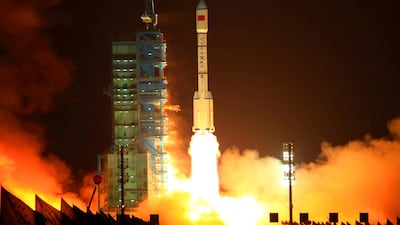The plunge back to Earth of a defunct Chinese space laboratory this week will not slow down Beijing's ambitious plans to send humans to the moon.
The Tiangong-1 space module, which crashed Monday, was intended to serve as a stepping stone to a manned station, but its problems highlight the difficulties of exploring outer space.
But China has come a long way in its race to catch up with the United States and Russia, which have lost spacecraft, astronauts and cosmonauts over the decades.
China's "taikonauts" have fared better and Beijing sees its military-run space programme as a marker of its rising global stature and growing technological might.
Here is a look at China's space endeavour through the decades, and where it is headed:
Mao's vow
Soon after the Soviet Union launched Sputnik in 1957, Chairman Mao Zedong pronounced "We too will make satellites."
It took more than a decade but in 1970 China's first satellite lifted into space on the back of a Long March rocket.
Human space flight took decades longer, with the first successful mission coming in 2003.
As the launch of astronaut Yang Liwei into orbit approached, angst over the viability of the mission caused Beijing to cancel a nationwide live television broadcast at the last minute.
Despite the suspense, it went off smoothly, with Mr Yang orbiting the Earth 14 times during his 21-hour flight aboard the Shenzhou 5.
Since then China has sent men and women into space with increasing regularity.
Space station and Jade Rabbit
Following in the footsteps of the United States and Russia, China is striving to open a space station circling our planet.
The Tiangong-1 was shot into orbit in September 2011.
In 2013, the second Chinese woman in space, Wang Yaping, gave a video class from inside the space module beamed back to children across the world's most populous country.
The lab was also used for medical experiments and, most importantly, tests intended to prepare for the building of a space station.
_______________
Read more:
Chinese space lab plunges back to Earth over Pacific
NASA astronauts go spacewalking days after reaching orbit
_______________
The lab was followed by the "Jade Rabbit" lunar rover in 2013 which looked at first like a dud when it turned dormant and stopped sending signals back to Earth.
The rover made a dramatic recovery, though, ultimately surveying the moon's surface for 31 months, well beyond its expected lifespan.
In 2016, China launched its second station, the Tiangong-2 lab into orbit 393 kilometres above Earth, in what analysts say will likely serve as a final building block before China launches a manned space station.
Astronauts who have visited the station have run experiments on growing rice and thale cress and docking spacecraft.
Space dream
Under the President Xi Jinping, plans for China's "space dream", as he calls it, have been put into overdrive.
The new superpower is looking to finally catch up with the US and Russia after years of belatedly matching their space milestones.
The ambitions start with a space station of its own, slated to begin assembling pieces in space in 2020 with manned use to start around 2022 - China was deliberately left out of the International Space Station effort.
China is also planning to build a base on the moon, the state-run Global Times said in early March, citing the Communist Party chief of the China Academy of Space Technology.
The outpost will initially be controlled by artificial intelligence robots until humans are sent to occasionally manage it, the official said.
But lunar work was dealt a setback last year when the Long March-5 Y2, a powerful heavy-lift rocket, failed to launch in July on a mission to send communication satellites into orbit.
The failure forced the postponement of the launch of lunar probe Chang'e-5, originally scheduled to collect moon samples in the second half of 2017.
The official Xinhua news agency quoted a China Lunar Exploration Programme designer as saying last week that the Chang'e 5 is now slated to land in 2019 and then bring back moon samples to Earth.
Another robot, the Chang'e-4, is still due to land in 2018 for the "first-ever soft landing and roving survey on the far side of the moon", said Zuo Wei, deputy chief designer of the CLEP Ground Application System.
China's astronauts and scientists have also talked up manned missions to Mars as it strives to become a "global space power".

